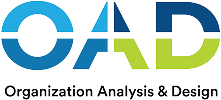Hiring isn’t just about filling seats — it’s your biggest competitive advantage. But only if you treat it like a strategy, not a scramble.
Table of Contents
- What Is a Talent Acquisition Strategy (And Why It Matters Now)
- Workforce Planning: Laying the Foundation for Talent Acquisition
- The True Cost of a Bad Hire
- Building a Strategic Recruitment Funnel
- Use Assessments to Screen for Fit, Not Just Skills
- Make Onboarding Part of Your Talent Strategy
- Talent Acquisition and Employee Engagement
- Application of Technology in Talent Acquisition
- Overcoming Challenges in Talent Acquisition
- Talent Acquisition and Employee Engagement: Closing the Loop
- Measure, Iterate, and Improve
- Conclusion: Turn Your Talent Acquisition Strategy Into a Competitive Advantage
- Ready to Hire Smarter? Test OAD for Free
What Is a Talent Acquisition Strategy (And Why It Matters Now)
A talent acquisition strategy is more than a hiring plan — it’s a framework that aligns your workforce with your company’s long-term goals.
An effective talent acquisition strategy helps move the company forward by aligning hiring efforts with organizational growth, future success, and overall business objectives.
Instead of scrambling to fill roles reactively, a strong talent acquisition strategy ensures your organization is consistently attracting, engaging, and retaining the right people — even before a position opens up. It connects the dots between your business objectives, company culture, and future workforce needs.
This is why talent acquisition is important: it plays a crucial role in the health and growth of your organization by ensuring you have the right people in place to achieve your goals.
Think of it this way: you wouldn’t build a marketing funnel without clear goals, targeted messaging, and measurable steps. So why approach hiring any differently?
At its core, an effective talent acquisition strategy focuses on:
- Proactive planning (not last-minute job postings)
- Targeted outreach to attract top-tier talent
- Consistent employer branding across every candidate touchpoint
- Structured hiring processes grounded in data and behavioral science
Companies with a solid strategy don’t just hire faster — they hire better. They attract stronger candidates, reduce turnover, and build a more resilient workforce.
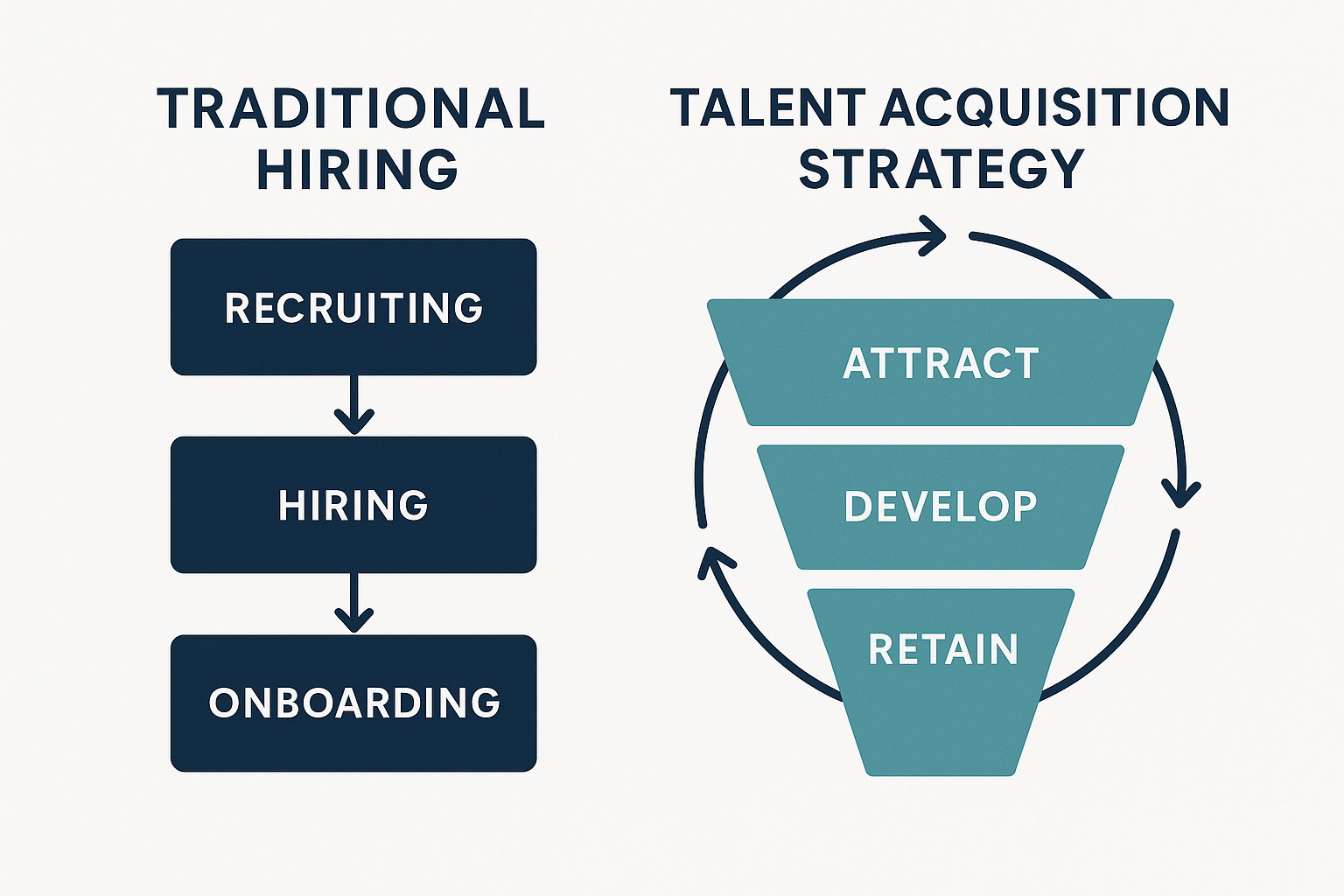
Workforce Planning: Laying the Foundation for Talent Acquisition
Every successful talent acquisition strategy starts with a clear picture of what your workforce looks like — and what it needs to become.
Workforce planning isn’t just about filling gaps. It’s about identifying the skills, roles, and capabilities that will drive your business forward in the next 6 months, 12 months, and beyond.
That starts with a deep analysis of your current talent pool:
- What skills do you already have?
- Where are the gaps — now and in the future?
- What talent will you need to reach your strategic goals?
This proactive approach helps HR teams align hiring with business objectives, rather than reacting to sudden vacancies or growth surges. It turns hiring from a scramble into a system.
From there, the strategy becomes tactical:
- Craft detailed job descriptions that reflect not just responsibilities, but the why behind the role
- Post with purpose — make sure your job postings reinforce your employer value proposition
- Activate your employee referral network to surface candidates who already fit your culture
The New Talent Imperative
In today’s hyper-competitive job market, having a clear talent acquisition strategy is no longer optional — it’s a business imperative.
Companies that continue to treat hiring as a transactional function are falling behind. The organizations that win top talent in 2025 don’t just post jobs and hope — they build magnetic employer brands, align their hiring with long-term business goals, and treat talent acquisition as a core driver of growth.
That means thinking beyond immediate headcount needs.
It means anticipating future skills gaps, understanding workforce planning, and creating a culture that attracts top-tier professionals before they even apply.
The best talent isn’t chasing jobs. They’re looking for companies that stand for something — and stand out.
A strong employer brand, paired with a strategic, forward-thinking talent acquisition approach, positions your organization not just to compete — but to lead.
The True Cost of a Bad Hire
Hiring mistakes aren’t just painful — they’re expensive.
A single bad hire can cost up to five times the employee’s annual salary once you factor in lost productivity, replacement costs, training, and team disruption. But the financial hit is only part of the story.
A poor fit can lower morale, stall momentum, and derail high-performing teams. And the worst part? Many of these hiring misfires are preventable with the right assessment and screening strategy in place.
The root of the problem isn’t always the candidate — it’s the process. Companies often rely too heavily on resumes and gut feelings while skipping critical steps like behavioral assessment, cultural alignment, and structured evaluation criteria. It’s essential to screen candidates thoroughly to determine their fit for specific roles and ensure they align with your organization’s needs.
That’s where a data-driven hiring process shines.
By integrating tools like personality assessments, skills testing, and culture-fit evaluations early in the funnel, you minimize guesswork — and maximize confidence in your hiring decisions. Focusing on skills rather than formal education helps identify candidates whose abilities directly contribute to better job performance.
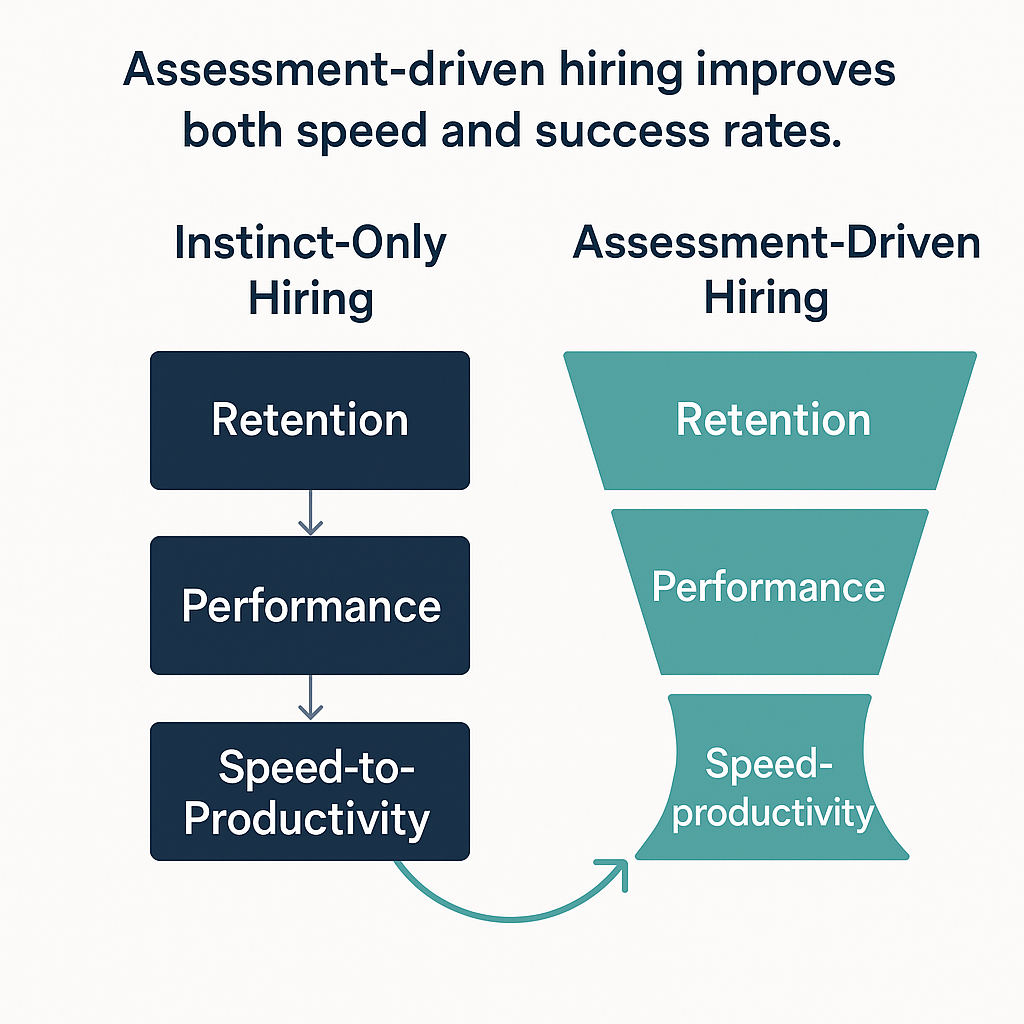
Building a Strategic Recruitment Funnel
Hiring success doesn’t happen by accident — it’s the result of a repeatable, optimized system.
A strategic recruitment funnel breaks the hiring process into structured, measurable stages. Documenting a structured recruitment process is essential for developing a repeatable and effective talent acquisition strategy that can be adapted over time. It’s not just about filling jobs. It’s about nurturing the right candidates from awareness to offer — with the same intentionality your marketing team uses to convert leads into customers.
The typical funnel includes:
- Awareness – job seekers discover your employer brand
- Attraction – detailed job descriptions, social proof, benefits packages
- Engagement – two-way communication, value-aligned messaging
- Assessment – screening candidates through structured interviews and tools
- Decision – selecting based on data, not gut
- Onboarding – reinforcing cultural alignment and productivity
Each stage is an opportunity to elevate the candidate experience, reinforce your employer value proposition, and move top talent through your funnel — while disqualifying mismatches early.
And just like in sales, the best results come from continuous optimization. Metrics like drop-off rates, time-to-fill, and candidate satisfaction help refine each stage over time.
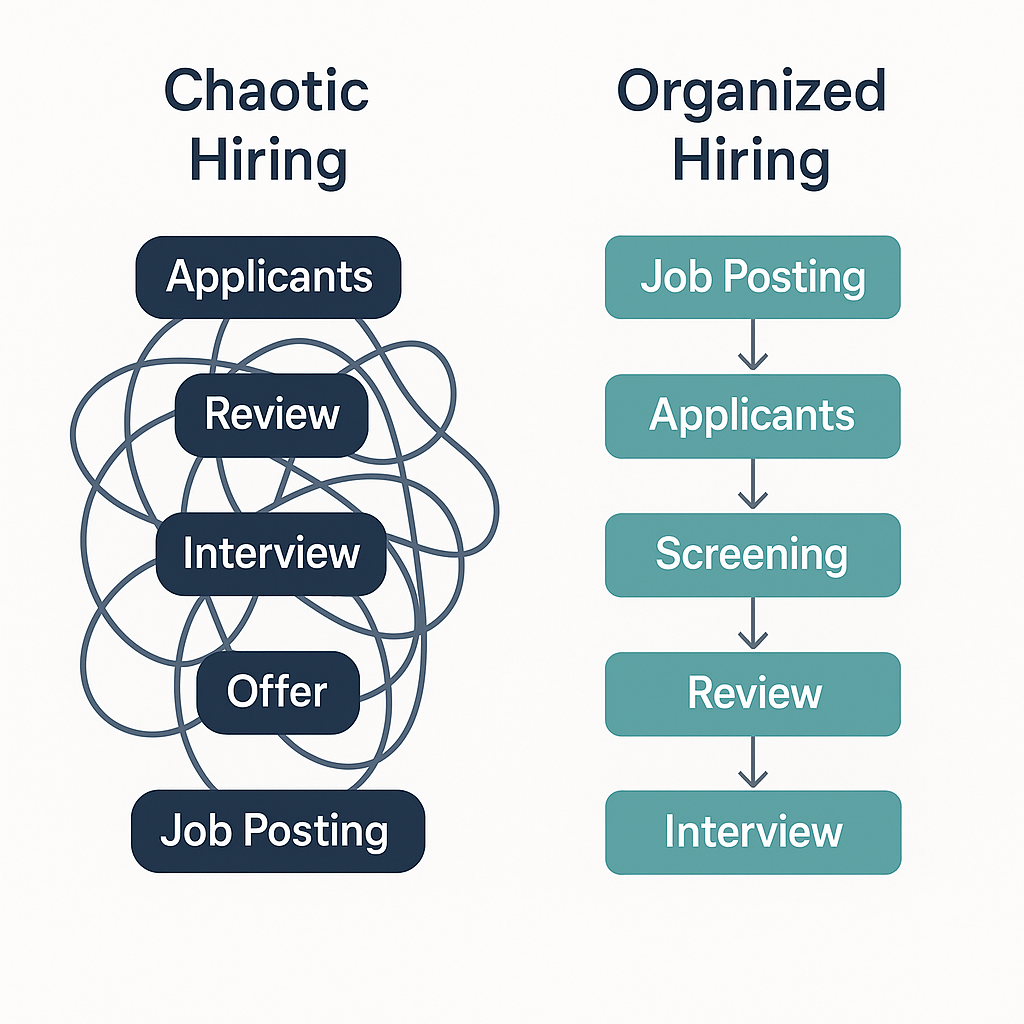
Create Detailed Job Descriptions That Attract the Right Talent
Most job descriptions read like an HR compliance checklist — and that’s exactly why they repel top-tier candidates.
In 2025, your job description is a marketing asset. It’s often the first interaction a potential candidate has with your company, and it sets the tone for your employer brand. A vague, jargon-filled list of responsibilities? That sends the message you haven’t put much thought into the role — or the person who will fill it.
A high-performing job post should:
- Clearly define the role’s impact on the organization
- Communicate growth opportunities and learning potential
- Highlight company values and culture alignment
- Speak directly to the type of person you want to attract — not just what you want them to do
- Promote job openings on social media platforms like LinkedIn and Instagram to increase visibility and attract a wider pool of candidates
And yes, it should still include required qualifications and job-related competencies. But don’t let those dominate the narrative. Lead with clarity and purpose, not legalese.
When written well, your job posting becomes a magnet for qualified candidates — especially passive ones who aren’t actively searching but are open to the right opportunity.
Optimize Your Employer Brand and Candidate Experience
Great candidates aren’t just evaluating your job — they’re evaluating your company.
Before they apply, they’ll scan your website, read employee reviews, and look for signals of what it’s really like to work for you. A well-designed company website can showcase your company values, highlight social responsibility initiatives, and provide a dedicated careers page or portal for job seekers. That’s why building a compelling employer brand is no longer optional. Strong employer branding is essential for attracting and engaging top talent in today’s market. It’s your most powerful tool to attract top-tier talent in a competitive market.
A strong employer brand communicates:
- What your company stands for
- What it feels like to work there
- Why people stay (or leave)
- How employees grow and contribute
But branding alone isn’t enough. The candidate experience must reinforce the promise your brand makes. Long delays, vague communication, or a confusing application process can quickly turn excited applicants into ghosted job seekers.
To strengthen your employer brand and candidate experience:
- Keep your application process simple and mobile-friendly
- Communicate expectations and timelines clearly
- Personalize your outreach and follow-ups
- Collect candidate feedback at every stage and use it to improve
The best companies treat candidates like customers — and that reputation spreads.
Leverage Internal Talent and Referral Networks
Sometimes, the best candidates are already inside your company — or just one introduction away.
A strategic talent acquisition strategy doesn’t just focus on external pipelines. It also prioritizes internal mobility and employee referral programs as critical tools for faster, better-fit hiring.
Why?
Because referred candidates:
- Are hired faster
- Stay longer
- Perform better And internal hires already know your culture, systems, and expectations. Promoting from within doesn’t just fill roles — it boosts morale, signals opportunity, and improves retention. Effective human resource management supports internal mobility, employee development, and retention by providing attractive benefits, flexible work arrangements, and growth programs.
To maximize your internal and referral networks:
- Publicize open roles internally before going external
- Encourage managers to recommend talent from their teams
- Offer structured employee referral incentives (with clear guidelines)
- Recognize and reward successful referrals — publicly
When your current employees feel engaged in the hiring process, they become your most powerful recruiters.

Diversify Your Sourcing Channels
If you’re only posting to job boards, you’re missing out on incredible talent.
Today’s top candidates don’t always come through traditional channels. In fact, some of the best hires are found through niche platforms, professional communities, or even social media — especially when they’re not actively looking.
An effective talent acquisition strategy casts a wider, smarter net by sourcing from:
- Niche job boards aligned with industry or function
- Employee referral programs (with targeted outreach)
- Social platforms like LinkedIn, X (Twitter), and Facebook groups
- University partnerships and job fairs for early talent
- Geo-targeted campaigns to attract local or relocation-ready candidates
- Passive candidate pools, maintained over time for future hiring needs
Smart companies don’t just rely on volume. Ongoing talent acquisition efforts, such as refining recruitment processes and leveraging social media, are essential to stay competitive. They customize their sourcing to match the behavior of their ideal candidates — and stay active in the places those candidates spend time.
Pro tip: Track what sourcing channels yield the best long-term hires, not just the most applicants.

Use Assessments to Screen for Fit, Not Just Skills
Resumes can tell you what a candidate has done — but not how they think, how they work, or whether they’ll thrive in your culture.
That’s why leading companies are turning to behavioral and personality assessments to go beyond gut instinct and build a repeatable, fair, and predictive hiring process.
When you screen for job-related competencies, culture fit, and learning potential, you reduce the risk of hiring someone who looks great on paper but underperforms in practice.
Tools like the OAD assessment are designed to measure:
- How candidates process information and solve problems
- Communication and leadership styles
- Alignment with company values and team dynamics
- Long-term growth potential and adaptability
Integrating a validated assessment early in your recruitment funnel helps you:
- Weed out poor fits before interviews
- Compare candidates using data, not bias
- Support fair hiring practices
- Improve overall hiring outcomes and retention
Using data analytics within an applicant tracking system can also help identify hiring trends, assess recruitment channel effectiveness, and forecast staffing needs, further improving your talent acquisition process.
Assessments also enhance the candidate experience — serious applicants appreciate a process that’s clear, thoughtful, and personalized.
Interview for Adaptability and Future Growth
Hiring solely based on past performance is a mistake — especially in a world where roles evolve faster than ever.
The most valuable employees in 2025 aren’t just experienced — they’re adaptable, self-motivated, and growth-oriented. That’s why the interview process should go beyond “Tell me about your last job” and dig into how candidates think, respond, and grow.
Modern talent acquisition strategies prioritize future potential over static credentials. Interviewing for adaptability and growth not only identifies high-potential talent, but also helps organizations anticipate and meet their future staffing needs.
Look for indicators like:
- Comfort with ambiguity and change
- Willingness to learn new tools and skills
- Resilience during failure or setbacks
- Curiosity and initiative
To uncover these traits, add behavioral questions like:
- “Tell me about a time you had to learn something completely new under pressure.”
- “Describe a situation where you failed — and how you recovered.”
- “How do you keep your skills sharp when the role isn’t evolving?”
These questions provide insight into emotional intelligence, learning agility, and cultural alignment — all of which are key predictors of long-term success.

Make Onboarding Part of Your Talent Strategy
Hiring doesn’t end with a signed offer — it begins.
Your onboarding process is one of the most critical drivers of employee retention, performance, and engagement. Yet too many companies treat it like an afterthought: a rushed orientation, a stack of paperwork, and a few awkward Zoom calls.
That’s not onboarding — that’s losing momentum.
In fact, research shows that a structured onboarding experience can improve new hire retention by up to 82% and increase productivity by more than 70%. A powerful onboarding strategy reinforces your employer brand, accelerates time-to-performance, and sets the tone for long-term growth.
Here’s what effective onboarding includes:
- A clear 30-60-90 day plan with defined milestones
- Introductions to team members and key stakeholders
- Culture immersion sessions (values, communication, rituals)
- Real-time feedback loops to check progress and resolve blockers
- A tailored training path — not one-size-fits-all
- An introduction to the company’s comprehensive benefits package, including health benefits, flexible work arrangements, and other perks
Treat onboarding as an extension of your talent acquisition strategy, not a handoff. When new hires feel prepared, supported, and connected from day one, they’re far more likely to stay — and succeed.
Talent Acquisition and Employee Engagement
The connection between talent acquisition and employee engagement is stronger than ever. A positive candidate experience doesn’t just help you secure top talent—it sets the stage for a strong employee experience that drives retention and performance. When new hires feel welcomed, supported, and valued from day one, they’re more likely to become engaged, high-performing team members.
Organizations should prioritize onboarding processes and training programs that help new hires ramp up quickly and feel confident in their roles. Providing clear growth opportunities and encouraging ongoing employee feedback ensures that your team remains motivated and aligned with your business objectives.
Integrating talent acquisition and employee engagement efforts creates a virtuous cycle: a strong talent acquisition strategy attracts the best candidates, while a focus on employee experience keeps them engaged and committed for the long haul. By listening to both candidate and employee feedback, you can continuously refine your hiring strategies and build a workplace where top talent thrives.
Application of Technology in Talent Acquisition
Modern talent acquisition runs on more than instinct — it runs on insight and automation.
Technology has redefined how companies attract, engage, and hire talent. From applicant tracking systems (ATS) to talent acquisition software, today’s tools empower HR teams to work smarter, not just faster.
These platforms automate repetitive tasks, centralize communication, and give hiring managers a bird’s-eye view of the recruitment funnel — even when managing dozens or hundreds of applications. For candidates, that translates to a smoother, faster, and more transparent experience.
But automation is just one part of the equation.
Smart companies also optimize their:
- Job boards — using targeted language, SEO, and segmentation
- Careers pages — to tell a compelling employer story and capture passive candidates
- Talent analytics dashboards — to spot bottlenecks and track hiring ROI
With the right data, you can pinpoint where strong candidates drop off, which sources yield the best hires, and how long it takes to convert qualified applicants into top performers.
Technology doesn’t replace human judgment — it enhances it.
By embedding smart tools into your talent acquisition strategy, you gain the clarity and control needed to hire at scale, without sacrificing quality or candidate experience.
Overcoming Challenges in Talent Acquisition
Hiring top talent in 2025 means navigating a landscape where candidates have more options, higher expectations, and less tolerance for outdated processes.
It’s no longer enough to offer a competitive salary. Today’s job seekers are looking for meaningful work, authentic values, and a candidate experience that reflects how they’ll be treated as employees. That puts pressure on HR teams and hiring managers to move faster, communicate better, and build stronger connections from the very first touchpoint.
To overcome these challenges, companies need to double down on what matters most:
- A compelling employer brand that reflects real culture — not corporate spin
- Employee referrals that tap into trusted networks of high-potential candidates
- A genuine commitment to building a diverse and inclusive workplace
- Personalized communication and timely feedback throughout the hiring journey
Together, these elements don’t just help you attract top candidates — they position your company as a place where great people want to work.
Great hiring isn’t just about selection. It’s about reputation, experience, and trust — long before an offer is ever made.
Talent Acquisition and Employee Engagement: Closing the Loop
The connection between talent acquisition and employee engagement is more than a handoff — it’s a feedback loop.
A great hiring experience doesn’t just help you win top candidates. It lays the foundation for long-term retention, performance, and cultural alignment. When new hires feel supported, respected, and empowered from day one, they’re more likely to become the kind of engaged employees that drive your business forward.
That’s why the most effective companies align their hiring and retention strategies from the start.
Key engagement drivers to build into your hiring process:
- A structured, thoughtful onboarding experience
- Clear expectations and early wins in the first 90 days
- Defined growth opportunities from day one
- Systems for collecting and acting on employee feedback
When candidates see consistency between the promises made during recruitment and the reality of life inside your company, trust is built — and engagement follows.
By integrating talent acquisition and engagement efforts, you create a virtuous cycle: great experiences attract better candidates, and better candidates become more engaged employees.
Measure, Iterate, and Improve
Even the best talent acquisition strategy needs regular refinement.
If you’re not tracking results, you’re guessing. And in today’s competitive hiring landscape, guessing costs time, money, and top candidates.
To continuously improve your recruitment funnel, you need to measure both the efficiency and effectiveness of your process — and be willing to pivot based on the data.
Key hiring metrics to monitor include:
- Time-to-fill – how long it takes to close each role
- Quality of hire – measured by performance, engagement, and retention
- Candidate drop-off rate – where and why people disengage
- Candidate feedback scores – insights into your brand and process perception
- Source of hire – which channels deliver the strongest long-term talent
But data alone isn’t enough. Use these insights to:
- Identify bottlenecks or inconsistencies in your funnel
- Adjust job postings or sourcing strategies
- Improve onboarding experiences
- Test new channels or employer branding content
The goal isn’t just to hire faster — it’s to hire smarter, more sustainably, and in full alignment with your company’s growth objectives.
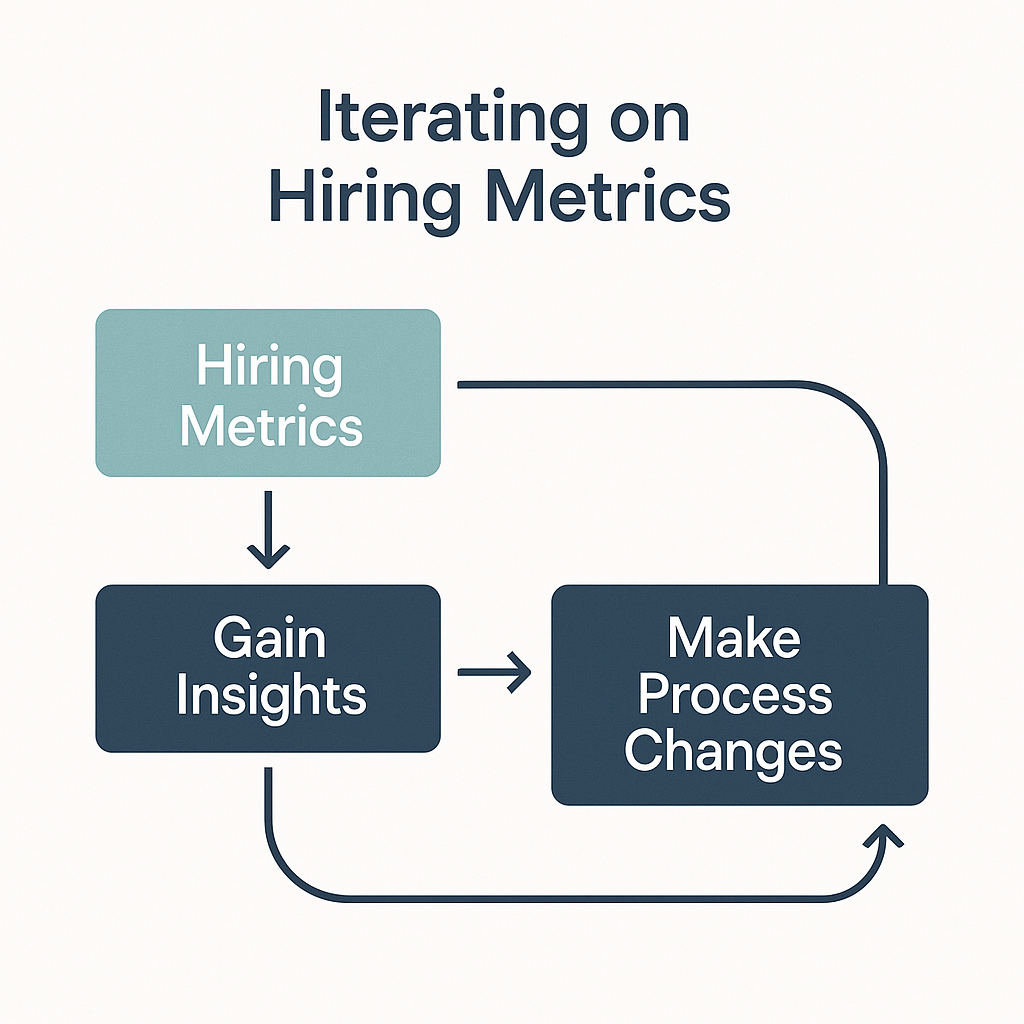
Conclusion: Turn Your Talent Acquisition Strategy Into a Competitive Advantage
Hiring shouldn’t feel like guesswork. And it doesn’t have to.
By shifting from reactive recruitment to a strategic talent acquisition approach, you’re not just filling roles — you’re building the foundation of your company’s future. A strong strategy aligns your people with your purpose, turns every candidate touchpoint into a brand builder, and creates a system that consistently delivers the right talent at the right time.
Let other companies settle for “good enough.”
You’re here to build a team that drives real results — and lasts.
Ready to Hire Smarter? Test OAD for Free
Want to see how data-driven hiring really works?
Discover how OAD’s scientifically validated assessment tool helps you:
- Identify high-potential candidates earlier in the funnel
- Match people to roles based on behavioral fit, not guesswork
- Reduce costly mis-hires — and retain top performers longer
Whether you’re scaling fast or optimizing your current team, we’ll show you how to make every hire count.
